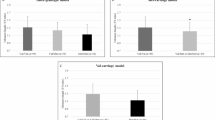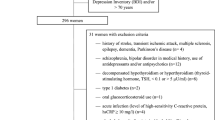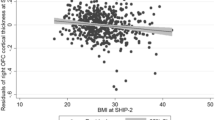Abstract
The goal of this study is to investigate the relationship between the Val66Met polymorphism in the brain-derived neurotrophic factor (BDNF) and body mass index (BMI) in two sizable and well-characterized populations of British women: the British Women's Heart and Health Study (BWHHS) (age 60–79 years) and the mothers from the Avon Longitudinal Study of Parents and Children (age 16–44 years). We genotyped the Val66Met polymorphism (rs6265) in these two populations, and conducted a linear regression analysis to test for an association between this polymorphism and BMI. Both study populations indicated an association between BMI and the Val66Met polymorphism, with individuals carrying the Met–Met genotype having a lower mean BMI than those with the Val–Met or Val–Val genotypes (in the BWHHS): mean BMI difference=−0.911 kg/m2, 95% confidence interval (CI): −1.70 to −0.12, P=0.023; in the mothers from the Avon Longitudinal Study of Parents and Children (ALSPAC): mean BMI difference=−0.57 kg/m2, 95%CI: −1.08 to −0.054, P=0.03). In a pooled analysis of these two studies, together with one further published study that provided data in a suitable format for inclusion in our meta-analysis, we found a pooled difference of −0.76 (95% CI: −1.16, −0.036) for adult women; I2–test for heterogeneity=51%, P=0.13. Our study indicated an association between BDNF and BMI in two general population studies of women. The exact role of BDNF in weight regulation merits further investigation.
Similar content being viewed by others
Log in or create a free account to read this content
Gain free access to this article, as well as selected content from this journal and more on nature.com
or
References
Lebrun B, Bariohay B, Moyse E, Jean A : Brain-derived neurotrophic factor (BDNF) and food intake regulation: a minireview. Auton Neurosci 2006; 126–127: 30–38.
Lyons WE, Mamounas LA, Ricaurte GA et al: Brain-derived neurotrophic factor-deficient mice develop aggressiveness and hyperphagia in conjunction with brain serotonergic abnormalities. Proc Natl Acad Sci USA 1999; 96: 15239–15244.
Kernie SG, Liebl DJ, Parada LF : BDNF regulates eating behavior and locomotor activity in mice. EMBO J 2000; 19: 1290–1300.
Rios M, Fan G, Fekete C et al: Conditional deletion of brain-derived neurotrophic factor in the postnatal brain leads to obesity and hyperactivity. Mol Endocrinol 2001; 15: 1748–1757.
El-Gharbawy AH, Adler-Wailes DC, Mirch MC et al: Serum brain-derived neurotrophic factor concentrations in lean and overweight children and adolescents. J Clin Endocrinol Metab 2006; 91: 3548–3552.
Gray J, Yeo GS, Cox JJ et al: Hyperphagia, severe obesity, impaired cognitive function, and hyperactivity associated with functional loss of one copy of the brain-derived neurotrophic factor (BDNF) gene. Diabetes 2006; 55: 3366–3371.
Ribases M, Gratacos M, Fernandez-Aranda F et al: Association of BDNF with anorexia, bulimia and age of onset of weight loss in six European populations. Hum Mol Genet 2004; 13: 1205–1212.
Ribases M, Gratacos M, Fernandez-Aranda F et al: Association of BDNF with restricting anorexia nervosa and minimum body mass index: a family-based association study of eight European populations. Eur J Hum Genet 2005; 13: 428–434.
Gunstad J, Schofield P, Paul RH et al: BDNF Val66Met polymorphism is associated with body mass index in healthy adults. Neuropsychobiology 2006; 53: 153–156.
Golding J, Pembrey M, Jones R : ALSPAC--the Avon Longitudinal Study of Parents and Children.I. Study Methodology. Paediatr Perinat Epidemiol 2001; 15: 74–87.
Jones RW, Ring S, Tyfield L et al: A new human genetic resource: a DNA bank established as part of the Avon Longitudinal Study of Pregnancy and Childhood (ALSPAC). Eur J Hum Genet 2000; 8: 653–660.
Friedel S, Horro FF, Wermter AK et al: Mutation screen of the brain derived neurotrophic factor gene (BDNF): identification of several genetic variants and association studies in patients with obesity, eating disorders, and attention-deficit/hyperactivity disorder. Am J Med Genet B Neuropsychiatr Genet 2005; 132B: 96–99.
Lawlor DA, Bedford C, Taylor M, Ebrahim S : Geographical variation in cardiovascular disease, risk factors, and their control in older women: British Women's Heart and Health Study. J Epidemiol Community Health 2003; 57: 134–140.
Draper NR, Smith H : Applied Regression Analysis. New York: Wiley, 1998.
Higgins JP, Thompson SG, Deeks JJ, Altman DG : Measuring inconsistency in meta-analyses. BMJ 2003; 327: 557–560.
Risch N, Merikangas K : The future of genetic studies of complex human diseases. Science 1996; 273: 1516–1517.
Colhoun HM, McKeigue PM, Davey Smith G : Problems of reporting genetic associations with complex outcomes. Lancet 2003; 361: 865–872.
Rowland ML : Self-reported weight and height. Am J Clin Nutr 1990; 52: 1125–1133.
Lawlor DA, Bedford C, Taylor M, Ebrahim S : Agreement between measured and self-reported weight in older women. Results from the British Women's Heart and Health Study. Age Ageing 2002; 31: 169–174.
Scuteri A, Sanna S, Chen WM et al: Genome-wide association scan shows genetic variants in the FTO gene are associated with obesity-related traits. PLoS Genet 2007; 3: e115.
Fox CS, Heard-Costa N, Cupples LA, Dupuis J, Vasan RS, Atwood LD : Genome-wide association to body mass index and waist circumference: the Framingham Heart Study 100K project. BMC Med Genet 2007; 8 (Suppl 1): S18.
Acknowledgements
The BWHHS is funded by the UK Department of Health and the British Heart Foundation.
Funding for the ALSPAC study has come from a wide variety of sources, including the University of Bristol, Welcome Trust, the Medical Research Council, UK Government Departments such as MAFF, Department of Health, Department for Education and the Health and Safety Executive. Other sources of funds include Medical Research Charities such as the Welcome Trust, the National Asthma Campaign, and American sources such as the National Institutes of Health and the March of Dimes charity.Debbie A Lawlor is funded by a UK Career Scientist Award. Nicholas J Timpson is funded by a UK Medical Research Council (MRC) studentship.The views expressed in this study are those of the authors and not necessarily of any funding agency. No funding agency has influenced the data analysis or its interpretation.
This work was written while Yin Yao Shugart was working at Johns Hopkins University. She is currently working at the Genomic Research branch at NIMH. The views expressed in this article do not necessarily represent the views of the NIMH, NIH, HHS, or the United States Government.
We would also like to thank the participants in both studies and the large number of staff who have collected, cleaned and managed data for both studies.
Author information
Authors and Affiliations
Corresponding author
Rights and permissions
About this article
Cite this article
Shugart, Y., Chen, L., Day, I. et al. Two British women studies replicated the association between the Val66Met polymorphism in the brain-derived neurotrophic factor (BDNF) and BMI. Eur J Hum Genet 17, 1050–1055 (2009). https://doi.org/10.1038/ejhg.2008.272
Received:
Revised:
Accepted:
Published:
Issue date:
DOI: https://doi.org/10.1038/ejhg.2008.272
Keywords
This article is cited by
-
The influence of the BDNF Val66Met genotype on emotional recognition memory in post-traumatic stress disorder
Scientific Reports (2023)
-
The bi-directional association between bipolar disorder and obesity: Evidence from Meta and bioinformatics analysis
International Journal of Obesity (2023)
-
The genetics of obesity: from discovery to biology
Nature Reviews Genetics (2022)
-
Association study of the BDNF gene polymorphism (G196A) with overweight/obesity among women from Northwest of Iran
Egyptian Journal of Medical Human Genetics (2021)
-
Sex difference in the association of body mass index and BDNF levels in Chinese patients with chronic schizophrenia
Psychopharmacology (2019)



